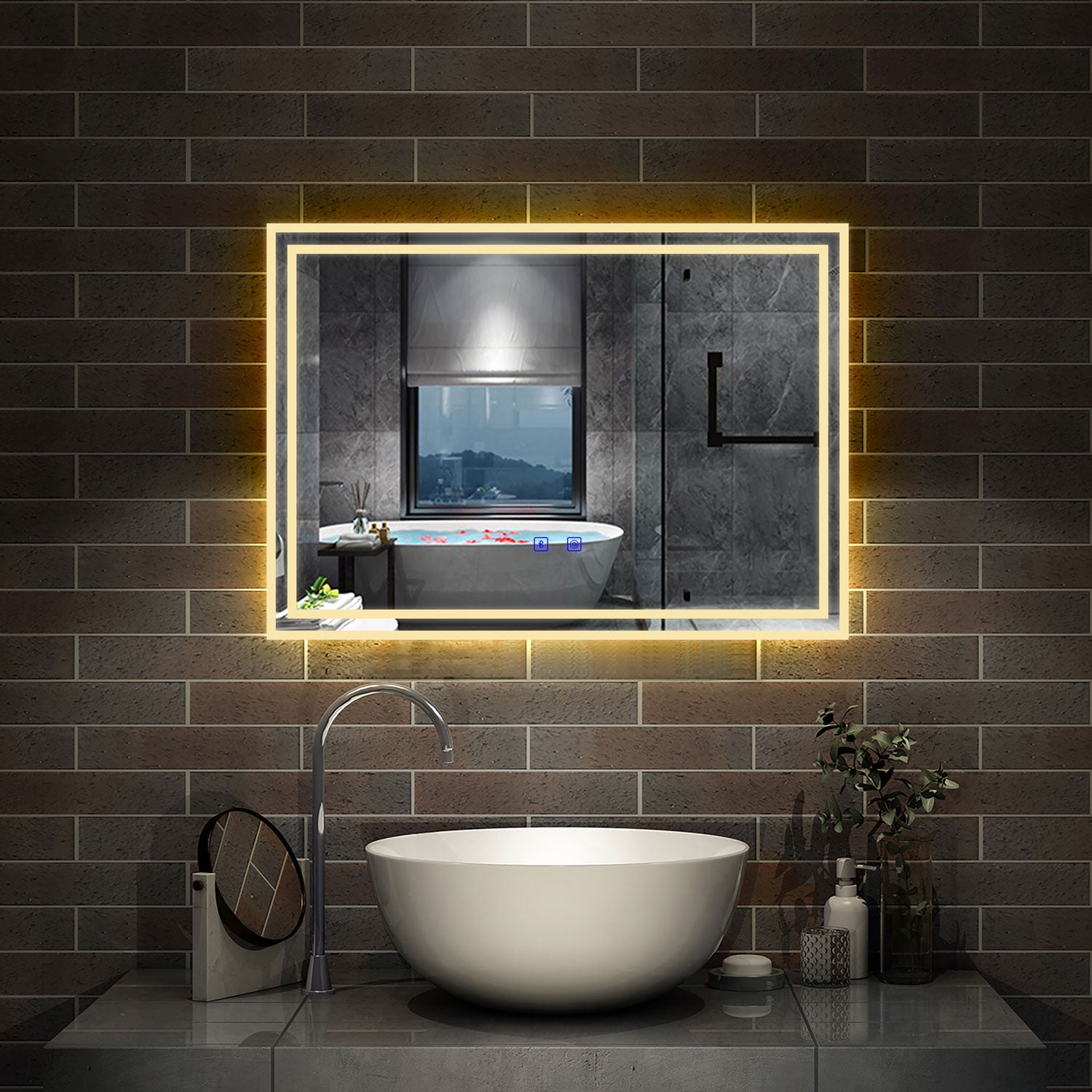In today’s modern bathrooms, illuminated mirrors have become increasingly popular. Not only do they add a touch of style and sophistication to the space, but they also serve a practical purpose by providing efficient lighting for grooming activities. But have you ever wondered how these illuminated bathroom mirrors actually work? In this comprehensive guide, we’ll delve into the intricate workings of illuminated bathroom mirrors, exploring their components, functionality, and installation process.
Understanding Illuminated Bathroom Mirrors

Illuminated bathroom mirrors, also known as LED mirrors or lighted mirrors, are equipped with integrated lighting elements that provide illumination for tasks such as shaving, applying makeup, or simply brightening up the space. Unlike traditional mirrors that rely on external lighting sources, illuminated bathroom mirrors feature built-in LED lights that offer uniform brightness and clarity across the mirror surface.
Components of Illuminated Bathroom Mirrors

To grasp how illuminated bathroom mirrors function, it’s essential to understand the key components that make up these innovative fixtures:
- Mirror Panel:The mirror panel is the central component of the illuminated bathroom mirror. It serves as the reflective surface that allows individuals to see their reflection clearly. Typically, these mirror panels are made of regular annealed glass coated with a thin layer of reflective aluminum or silver. This coating transforms the clear glass into a mirror by reflecting light, creating a crisp and accurate reflection.
- LED Lighting:LED lighting plays a crucial role in illuminating the bathroom mirror. LED light strips are strategically positioned along the edges or perimeter of the mirror panel. These LED lights provide bright and energy-efficient illumination, ensuring optimal visibility for grooming tasks. LED technology is preferred for illuminated mirrors due to its longevity, energy efficiency, and ability to produce a uniform and flattering light.
- Power Source:The power source is essential for powering the LED lights within the illuminated bathroom mirror. There are two primary methods of powering these mirrors: hardwiring into the bathroom’s electrical system or using a plug-in cord connected to an electrical outlet. Hardwired mirrors offer a seamless appearance with no visible cords, while plug-in options provide more flexibility for installation in different locations. Ensuring a reliable power source is crucial for consistent and effective illumination.
- Light Diffusion Panels:Light diffusion panels are installed over the LED light strips to distribute light evenly across the mirror surface. These panels are typically made of translucent materials such as acrylic or polycarbonate. They feature dot or ripple patterns that effectively scatter the light, preventing harsh shadows and glare. By diffusing the light, these panels ensure a soft and uniform illumination that enhances visibility and eliminates any hot spots or uneven lighting.
- Controls:Controls are integrated into illuminated bathroom mirrors to provide users with the ability to customize their lighting experience. These controls may include switches, sensors, remote controls, or touch-sensitive interfaces. Users can adjust the brightness and color temperature of the LED lights according to their preferences, creating the perfect ambiance for any task or mood. This level of control allows individuals to tailor the lighting to suit their grooming needs, whether they require bright, daylight-like illumination or a softer, warmer glow.
How Illuminated Bathroom Mirrors Work

Now that we’ve examined the components of illuminated bathroom mirrors, let’s explore how these elements work together to provide efficient and aesthetically pleasing lighting:
- LED Lighting Operation:Illuminated bathroom mirrors utilize LED (Light Emitting Diode) technology to provide efficient and uniform lighting. LED light strips, strategically positioned around the edges or perimeter of the mirror panel, emit light when powered on. These LED lights produce bright illumination while consuming minimal energy. Due to their small size and low heat emission, LEDs are ideal for use in bathroom mirrors. They offer longevity and reliability, ensuring consistent performance over time.
- Light Diffusion:To ensure even distribution of light across the mirror surface, diffusion panels are installed over the LED light strips. These panels are typically made of translucent materials such as acrylic or polycarbonate. They feature patterns or textures designed to scatter the light evenly, preventing glare and hot spots. By diffusing the light, these panels create a soft and uniform illumination that enhances visibility without causing discomfort to the eyes.
- Power Source Activation:Illuminated bathroom mirrors are activated through either hardwiring into the bathroom’s electrical system or using a plug-in cord connected to an electrical outlet. Hardwired mirrors are connected directly to the electrical wiring of the bathroom, ensuring a seamless and permanent power source. Plug-in mirrors offer more flexibility and can be easily installed in any location with access to an electrical outlet. Once connected to the power source, the LED lights within the mirror are activated, providing instant illumination.
- Adjustability Features:Many illuminated bathroom mirrors come equipped with adjustable settings for brightness and color temperature. Users can customize the lighting according to their preferences and needs. Brightness settings allow users to adjust the intensity of the light, providing optimal illumination for different tasks such as shaving, applying makeup, or simply brightening up the space. Color temperature settings enable users to select between warm or cool tones, creating the desired ambiance in the bathroom.
- Integration with Controls:Controls are integrated into illuminated bathroom mirrors to facilitate easy operation and customization of lighting settings. These controls may include switches, sensors, remote controls, or touch-sensitive interfaces. Users can conveniently adjust the brightness and color temperature of the LED lights using these controls, ensuring a personalized lighting experience. Some advanced models may also feature smart technology, allowing users to control the mirror’s lighting remotely via smartphone apps or voice commands.
Installation Process

Installing an illuminated bathroom mirror requires careful planning and attention to detail. Here’s a step-by-step overview of the installation process:
- Preparation:Before beginning the installation process, it’s essential to prepare the space and gather the necessary tools and materials. Start by selecting a suitable location for the mirror, taking into account factors such as lighting, accessibility, and aesthetics. Ensure that there is a nearby power source if opting for a hardwired installation. Clear the area around the chosen location to provide ample space for mounting the mirror.
- Mounting:Once the location has been determined, securely mount the illuminated bathroom mirror to the wall using appropriate brackets or mounting hardware. Ensure that the mirror is level and properly aligned with the surrounding space. Depending on the design of the mirror, it may come with built-in mounting brackets or require additional hardware for installation. Take care to follow the manufacturer’s instructions and recommendations for proper mounting techniques.
- Wiring:For hardwired installations, route the electrical wiring through the wall to connect the mirror to the bathroom’s electrical system. This step may require cutting into the wall to create a pathway for the wiring. It’s essential to hire a licensed electrician to ensure compliance with safety regulations and proper wiring techniques. For plug-in installations, simply plug the mirror into an electrical outlet located nearby. Ensure that the outlet is accessible and compatible with the mirror’s plug.
- Testing:Once the mirror is securely mounted and connected to the power source, it’s time to test the LED lights to ensure they are functioning correctly. Turn on the power and activate the lights using the designated controls or switches. Verify that the lights illuminate evenly and provide the desired brightness and color temperature. Test all functions and adjust settings as needed to ensure optimal performance.
- Finishing Touches:With the mirror successfully installed and tested, it’s time to add any finishing touches to complete the installation process. This may include applying trim or caulking around the edges of the mirror to create a seamless and polished look. Clean the mirror surface to remove any fingerprints or smudges accumulated during installation. Step back and admire the newly installed illuminated bathroom mirror, appreciating its stylish design and functional lighting capabilities.
Conclusion
Illuminated bathroom mirrors offer a perfect blend of style and functionality, enhancing the aesthetics of any bathroom while providing efficient lighting for grooming tasks. By understanding the components and operation of these innovative fixtures, homeowners can make informed decisions when selecting and installing illuminated mirrors in their bathrooms. With their sleek design, customizable lighting options, and easy installation process, illuminated bathroom mirrors are sure to illuminate any space with elegance and sophistication.
